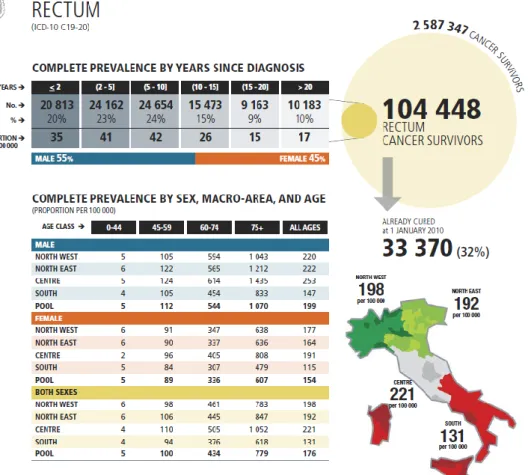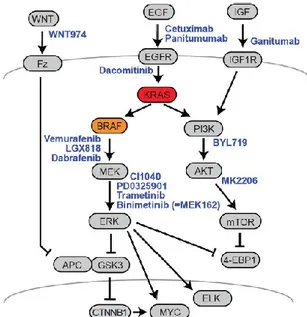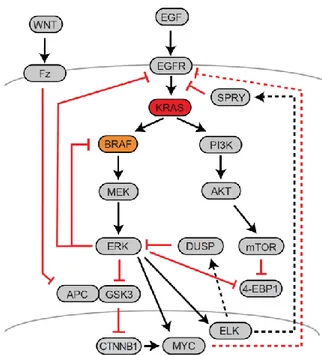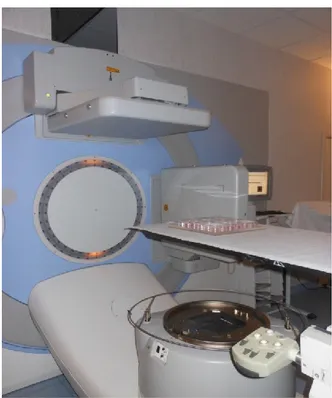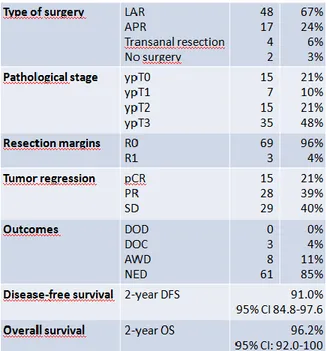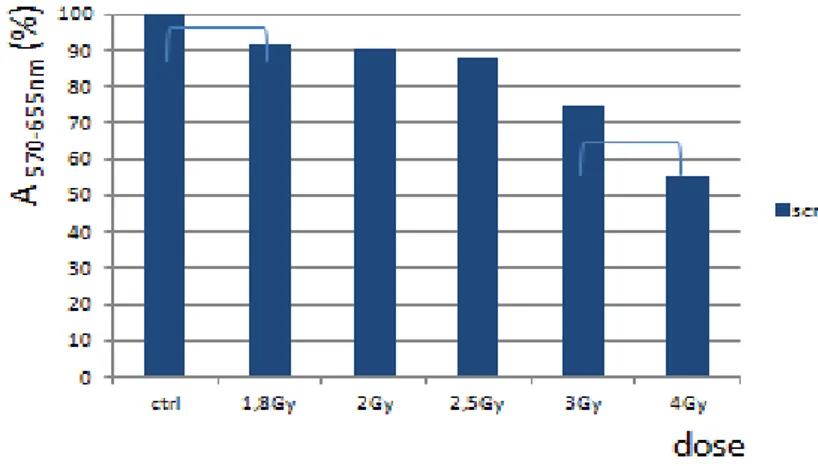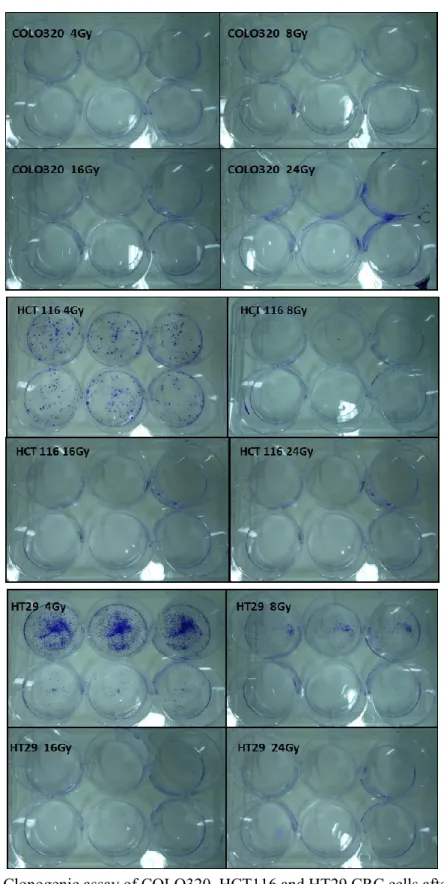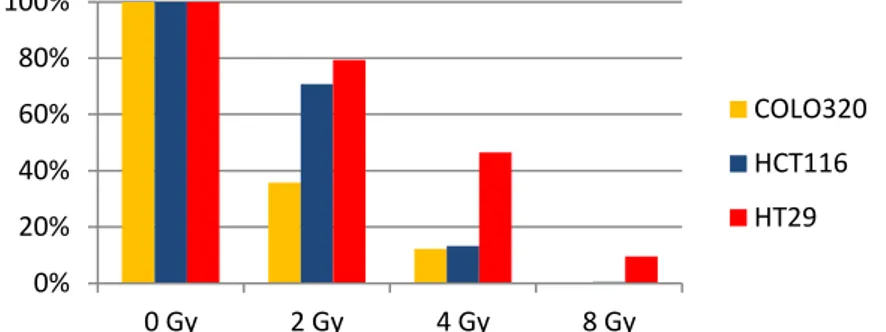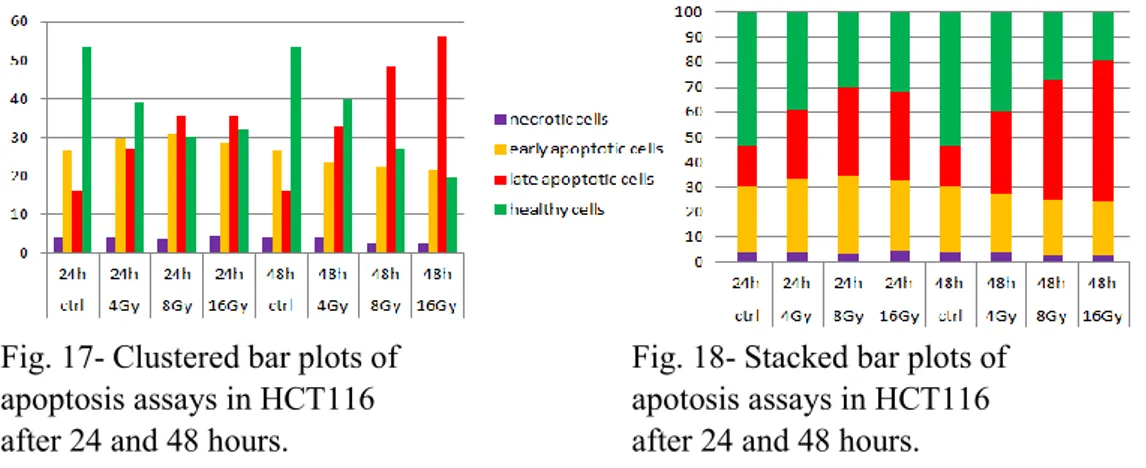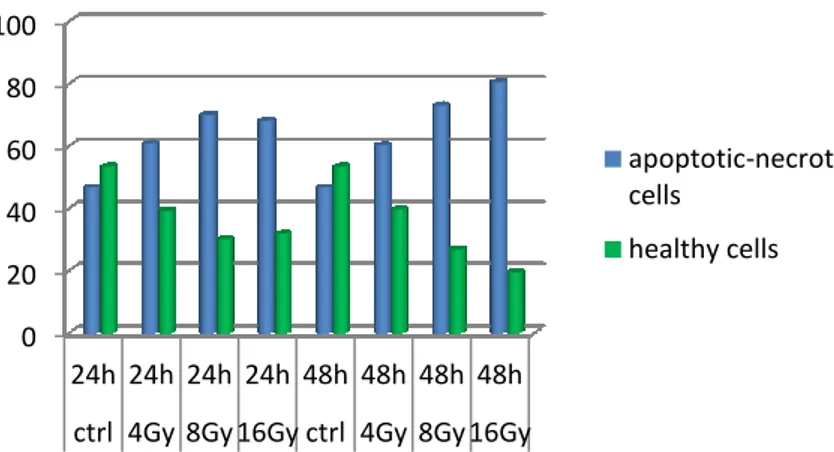1
Indice
Abstract………... 3
Introduction………. 9
1. Rectal cancer and chemoradiation……… 12
1.1 Pretreatment evaluation……… 14
1.2 Preoperative versus postoperative radiation……….. 16
1.3 Long-course or short-course radiation………. 18
1.4 Concurrent chemoradiation………. 20
1.5 Addition of capecitabine……… 23
1.6 Addition of oxaliplatin……….. 24
1.7 Addition of targeted agents……….. 25
1.8 Technique of radiation therapy……… 26
1.9 Preoperative restaging after neoadjuvant therapy………. 27
1.10 Timing of surgery after preoperative radiation……….. 28
1.11 Surgery………. 29
1.12 Pathological evaluation of tumour response and perspectives…. 30
2. Molecular basis of chemoradiosensitivity in rectal cancer.. 34
2.1 Whole-genome analyses………. 35
2.1.1 Gene expression profiling……….. 35
2.1.1.1 Microarrays in tumour tissue………... 35
2.1.1.2 Microarrays in peripheral blood………. 38
2.1.1.3 Microarrays of microRNA………. 39
2.1.2 Chromosomal aberrations………. 40
2.2 Single-biomarker and multibiomarker analyses………..………. 41
2.2.1 Single-nucleotide polymorphisms……….…… 41 2.2.2 Immunohistochemistry……… 43 2.2.2.1 Cell cycle……….44 2.2.2.2 Proliferation markers………. 48 2.2.2.3 Apoptosis……… 49 2.2.2.4 Angiogenesis………. 52
3. The MAPK network: KRAS and BRAF……….. 55
4. Materials and methods………. 65
4.1 Patients and chemoradiotherapy……… 65
4.2 Cell cultures, siRNAs and chemicals………. 67
2
4.4 Colorimetric MTT assays……….. 70
4.5 Apoptosis assays………. 71
4.6 Colony forming assays……….. 71
4.7 Immunoblot analysis……….. 72
4.8 Statistical analysis……….. 73
5. Results……….. 74
5.1 Pathological and clinical outcomes of chemoradiation……… 74
5.2 Dose finding for in-vitro experiments………. 76
5.3 Radioresistance after exclusive radiation treatment……….. 77
5.4 The effects of chemotherapy on radiation resistance………. 83
5.5 BRAF silencing/inhibition……… 86
5.6 TRAP1 silencing/inhibition……….. 88
6. Discussion……… 97
7. Conclusion……….. 113
3
Abstract
Keywords: rectal cancer, radiation resistance, BRAF mutations, TRAP1. Introduction
Radiotherapy is a well-established therapeutic modality for cancer. It is considered a crucial treatment for most common types of cancer and is usually used in conjunction with chemotherapy, hormone therapy or surgery. However, the presence of radioresistant cells is one of the major obstacles to successful treatment with radiotherapy.
Ionizing radiation exerts its cytotoxic effect by the induction of double strand breaks (DSBs) and non-DSB highly clustered DNA lesions consisting in a combination of single strand breaks (SSBs), abasic sites and oxidized bases within 5–10 base pairs.
Radiation is known to activate multiple signaling pathways, causing cancer cells to become inactivated and resulting in diverse types of stress responses, including apoptosis, cell cycle arrest, senescence and gene induction. However, a large number of tumours fail to respond to radiotherapy as they are less sensitive or more resistant to radiation.
Various studies on the molecular mechanisms of resistance to radiotherapy have been carried out. However, obstacles related to overcoming this resistance remain to be solved. Therefore, identification of the radiation-responsive genes may aid to better understand the molecular mechanisms involved in the response of tumours to radiation and, ultimately, improve radiotherapy.
We focused our attention on colorectal cancer (CRC), which is one of the three leading causes of cancer deaths worldwide. Most colorectal cancers are sporadic, with dietary risk factors implicated in their development. Despite curative surgery, patients still have a significant probability of disease relapse and poor survival. Much interest has been generated in the last years in neoadjuvant treatment that would improve operability and prevent recurrent diseases.
Neoadjuvant chemoradiotherapy is an area of active research in rectal cancer. Indeed, outcomes of patients with rectal cancer have improved over the last decade, but this benefit has not extended to all subtypes of this disease. Many trials have been conducted to improve the outcome and decrease recurrence possibility. It is without doubt that tracing the underlying molecular mechanisms within the adopted strategy for cell death is a cornerstone for the
4
success of such trials. The purpose of our study was to evaluate if inhibition of determinate key points could enhance radiosensitivity in colorectal cancer cell lines.
Materials and Methods
Patients (pts) and neoadjuvant therapy. Between October 2006 and December 2013, 116 pts with locally advanced or distal T2 rectal tumours were treated by chemoradiation followed by surgery. Median follow-up was 66 months (IQR 56–73) for all pts.
Cell lines. We used cells of human colorectal adenocarcinoma: COLO320 (RAS and BRAF wild-type), HCT116 (RAS-mutated), HT29 (V600E BRAF mutated). Cell lines were supplied by the American Type Culture Collection (ATCC).
Chemotherapeutic. 5-fluorouracil (5-FU), commonly used to treat colorectal malignancies in association with radiotherapy. 5-FU was used at concentration of 5-500 nM.
Inibitors. PLX4720, a potent and selective inhibitor of the V600E mutant form of the B-Raf protein, and HSP990, a dual HSP90/TRAP1 inhibitor.
Gene silencing by siRNA. Cells were transfected with BRAF-targeting siRNA, TRAP-targeting siRNA or nontargeting siRNA.
Cell culture. Cells were seeded in a 6-well plate at a density of 300 and grown in a medium containing 10% heat-inactivated fetal bovine serum. The cells were maintained in a humidified atmosphere containing 5% CO2 at 37˚C.
Irradiation. A preliminary dosimetric study was necessary. Plates with cell lines were CT scanned. The CT data were imported into a treatment planning system and elaborated allowing isodose coverage of 95–107%: 1 cm plexiglas layer was used for radiation dose build-up, due to its tissue equivalent characteristics. Radiation was carried out at room temperature and delivered with 1.8-24 Gy, using a therapeutic linear accelerator (Elekta Sinergy) and 6-MV X-rays.
Cytofluorimetric Assay. After irradiation, cell lines were labeled using the Annexin V-FITC (fluorescein isothiocyanate) / 7-AAD (7-amino-actinomycin D) kit. Apoptosis was assessed by flow cytometric analysis of Annexin V and 7-AAD positive cells.
Clonogenic Survival Assay. Cell were grown in standard medium for about 2 weeks after irradiation to assess the capacity to form colonies. Cells were fixed with cold methanol for 25 minutes and stained with 1% crystal violet. The
5
number of colonies containing at least 50 cells was determined. Surviving fractions for each treatment were determined by normalizing the average plating efficiency for each dose to the plating efficiency at 0 Gy.
Western Blot. Cell lysates were prepared using buffer containing phosphatase and protease inhibitors and protein concentration was determined. Equal amounts of protein were subjected to electrophoresis performed under reducing conditions and gels were blotted to nitrocellulose membranes. All western blotting experiments were conducted in duplicate.
Statistical analyses. Comparison of the relative sensitivity of the cell lines was conducted using Analysis of Variance for three or more groups. Unpaired t-tests were used for comparisons of cytotoxicity between two conditions or cell lines.
Results and Discussion
Although current total mesorectal excision is curative for small tumours, the risk of locoregional recurrence, distant metastasis and death increases with tumours extending through the muscularis propria (T3 or T4) or nodal involvement (N1 or N2; stage II and III tumors).
One strategy to minimize recurrence in patients with rectal cancer is neoadjuvant chemoradiotherapy. Preoperative ionizing radiation downstage tumours and is well tolerated. Ionizing radiation, however, results in a wide spectrum of clinical response and the magnitude of benefit is heterogeneous. We analyzed our cohort of pts with locally advanced or distal T2 rectal tumours and we observed 21% pathological complete responses, 39% partial responses and 40% stable diseases. The estimated 2-year disease-free survival was 91.0% (95% CI 84.8-97.6). The estimated 2-year overall survival 96.2% (95% CI: 92.0-100).
One of the hallmarks of cancer cells is the up-regulation of cellular pathways that provide survival advantages by promoting proliferation and/or decreasing cell death. We evaluated the hypothesis that the RAS/RAF mutational status may influence cell response/resistance to radiation/chemoradiation. Upon analysis of clonogenic ability and apoptotic response to radiation in HCT116, COLO320 and HT29 cell lines, COLO320 cells showed sensitivity to radiation, while HT29 cells (BRAF-mutated) revealed to be the more radioresistant and HCT116 cells (KRAS-mutated) an intermediate phenotype. Our data suggest that resistance to ionizing radiation is mediated by activation of the Ras/MAPK pathway. Such pathway is the
6
Ras/Raf/mitogen activated protein kinase (MAPK)/extracellular signal regulated kinase (ERK) pathway, which is involved in cell proliferation, differentiation, apoptosis, and survival.
CRCs frequently exhibit activation of the Ras/MAPK pathway via activating mutations in Ras and/or Raf. The presence of either a Ras or Raf mutation is associated with an inferior prognosis compared to non-mutated tumours. Less than 10% of patients with metastatic CRCs have tumours with a point mutation in BRAF, a component of the RAF/MEK/ERK signaling pathway. Similar to other cancers, more than 95% of the BRAF mutations in CRC affect the V600 position of the protein, resulting in constitutive RAF/MEK/ERK pathway activation.
Inhibition of the Ras/MAPK pathway has also been exploited as a means to sensitize tumours cells to cytotoxic chemotherapy. As some studies hypothesized, in our experience inhibition of signaling via the Ras/MAPK pathway enhances sensitivity also to radiation.
To assess if specific inhibitors could enhance the radiation sensitization observed with 5-FU, we performed clonogenic survival assays with three tumour cells lines. Doses of X-rays and inhibitors and timing of 5-FU were chosen based on published data and preliminary work performed in our laboratory confirming radiation sensitization.
In all cell lines the combination of 5-FU and radiation showed to arrest cell growth to a greater extent compared to radiotherapeutic treatment alone. However, HT29 cells were confirmed to be more resistant than COLO320 and HCT116 cells also to the combination of 5-FU and radiation.
Inhibition of RAS/RAF/ERK pathway was evaluated as a strategy to sensitize rectal cancer cell lines to radiation. This was achieved by specific BRAF inhibitors, BRAF silencing and HSP990, a dual inhibitor of HSP90 and TRAP1. The inhibition of B-Raf protein with PLX4720 showed a moderate but not significant sensitizing effect, according to literature results. Conversely, BRAF siRNA silenced cells resulted significantly more sensitive than control and negative transfected cells. HSP990 significantly increases the radiosensitivity of BRAF-mutated cells, consistently with the chaperoning activity of HSP90 chaperones toward BRAF.
TRAP1 is a HSP90 molecular chaperone deregulated in human tumours and responsible for specific features of cancer cells, i.e., protection from apoptosis, drug resistance, metabolic regulation, and protein quality control/ubiquitination. Because HSP90 is the main molecular chaperone
7
responsible for BRAF folding, with specific affinity greater for its mutated form, HSP90 targeting is presently evaluated as an antitumour strategy in human BRAF-mutated neoplasms. In this scenario, we found that TRAP1 could play a role in radiation resistance. Indeed, transfection of resistant HT29 cells with TRAP1 siRNAs increased cancer cell killing. The role of TRAP1 in radioresistance is confirmed in stable clones of HCT116 cells in which TRAP1 is silenced. Lastly, with daily irradiation the expression of TRAP1 increased, suggesting a role also in the adaptive response to radiation.
Conclusions
Concurrent radiotherapy and radiation sensitizing 5-FU based chemotherapy is a common treatment strategy for colorectal malignancies. Despite aggressive chemoradiotherapy, a subgroup of tumours which undergo to chemoradiation do not achieve a clinically valuable response and local failure remains a troubling clinical problem that requires development of more effective regimens. In such a context, CRCs are known to frequently have activation of the Ras-Raf-MEK-ERK pathway via activating Ras/Braf mutations or EGFR pathway activation, and this likely represents a mechanism responsible for resistance to chemoradiation. Specifically, our study highlight the relevance of BRAF mutations as determinant of radioresistance.
To improve outcomes in patients with CRCs with a BRAF mutation, there is a critical need to better understand the mechanisms of resistance. We describe our attempts to enhance the radiation response with 5-FU. Our data suggest that concurrent treatment with 5-FU may be used in patients with colorectal malignancies to augment radiation response.
Our study shows that in CRC cell lines there is a relationship between V600E BRAF mutation and response to radiation with or without 5-FU, suggesting that BRAF mutation might be used as a predictive biomarker of response to neoadjuvant therapy in CRCs. However, the low frequency of V600E BRAF mutation must be considered (3-15%), as well as the need to confirm in vivo the results we have obtained.
Our study also suggests that the inhibition of molecules as TRAP1, involved in the regulation of B-Raf, may represent a treatment strategy for V600E-mutated CRCs, a subgroup characterized by a more aggressive biological behavior and a reduced responsiveness to conventional treatments.
In conclusion, our study may aid in better understanding the molecular mechanism that control response to radiation in cancer cells. Additionally, our
8
findings may contribute to the development of more effective strategies of combining radiation therapy with other systemic therapies. Our results provide rational therapeutic strategies for clinical studies in this poor prognosis subtype of CRC.
9
Introduction
Colon and rectal cancers are typically grouped and staged similarly. However, their management is different. Owing to the pelvic location of the rectum and its proximity to the anal sphincter and bladder, as well as to sympathetic and parasympathetic nerves, patients with rectal cancers present a substantial surgical challenge compared with individuals affected by colon cancer. Although current sharp radial resection of the tumour (total mesorectal excision) is curative for small tumours, the risk of locoregional recurrence, distant metastasis and death increases with tumours extending through the muscularis propria (T3 or T4) or nodal involvement (N1 or N2; stage II and III tumours).
One strategy to minimize recurrence in patients with rectal cancer is neoadjuvant chemoradiotherapy. Preoperative ionizing radiation might downstage tumours, facilitate surgical intervention, minimize surgical complications and decrease locoregional recurrence. Individual, randomized, controlled studies using low doses of neoadjuvant radiation therapy have failed to demonstrate a survival advantage in patients with rectal cancer. Yet, recent studies employing higher doses of preoperative radiation and chemotherapy revealed a distinct survival advantage utilizing this preoperative modality.
Regardless of the benefits in locoregional recurrence or survival in patients subjected to ionizing radiation, a major objective of this preoperative treatment is to reduce the tumour. Complete pathological response has been observed in most studies evaluating neoadjuvant chemoradiation, and it is a desirable outcome prior to surgical intervention. The rate of complete response in a given patient population is an objective and measurable outcome to assess the effectiveness of a neoadjuvant chemoradiotherapeutic regimen. Pre-sensitizing agents have classically been 5-fluorouracil-based given in combination with ionizing radiation. However, regardless of the preoperative agent used (i.e., 5-fluorouracil, irinotecan, oxaliplatin, capecitabine, bevacizumab and cetuximab), the rate of complete response remains substantially wide.
Preoperative radiation, alone or in combination with chemotherapy, results in a tremendously wide range of response. From one side of the spectrum, 10-25% of patients are able to achieve a complete pathological response following neoadjuvant chemoradiation. Yet, on the other side of this wide range, a considerable number of patients do not respond to ionizing radiation. In fact, in some cases, the tumour continues to grow in spite of neoadjuvant treatment.
10
Thus, the magnitude of benefit is heterogeneous across all trials and the ability of neoadjuvant therapy to minimize tumour burden is extraordinarily unpredictable.
While patients with breast cancers are not subjected to the adverse side effects of tamoxifen or trastuzumab if their tumours are negative for estrogen, progesterone or Her-2/Neu, neoadjuvant ionizing radiation with concurrent chemotherapeutic agents is administered almost universally to patients with stage II/III rectal cancers, despite the tremendously wide range of response to this preoperative modality in patients receiving the same form of treatment. The specific phenotype of the tumour plays a major role in rendering tumour survival advantage to the cytotoxic effects of chemoradiation. Pathways such as proliferation, cell cycle, apoptosis and hypoxia have been investigated under a variety of conditions in pre-irradiated tissues and post-irradiated tumours.
Ionizing radiation results in intracellular free radical formation, which leads to DNA damage by causing DNA base damage, DNA single-strand breaks (SSBs), DNA double-strand breaks (DSBs), DNA protein cross-links and installed replication forks. Alternatively, membrane effects cause signal transduction, which might result in gene expression of cell cycle regulators, growth factor production, or oxidative-stress pathway activation. Another pathway leading to cell death by ionizing radiation results from the induction of DNA damage, which interferes with DNA replication leading to premature segregation into mitosis and defects in maintaining cell cycle arrest. This leads to mitotic catastrophe.
The classical pathway of radio-induced cell death begins with signal transduction mechanisms that cause cell cycle arrest and initiate DNA repair mechanisms. If the cell is unable to successfully repair the DNA damage induced by ionizing radiation, it undergoes apoptosis. Radiation injury causes increased levels of p53, and cell cycle arrest ensues via the up-regulation of cyclin-dependent kinase inhibitors p21 and p27. DNA damage leads to an increase in p53, which then causes cell cycle arrest via an increase in cyclin-dependent kinase inhibitor (p21). If the cell is unable to repair itself, the sustained levels of p53 lead to a release of BAX, which then leads to apoptosis. Bcl-2 keeps a baseline suppression on p53. Similarly, p53 down-regulates survivin, which in turn stimulates apoptosis by removing the inhibitory effects of survivin on the caspases.
Resistance to drugs and radiation is the major cause of anticancer treatment failure in rectal cancer. Indeed, resistance is a multifactorial phenomenon
11
involving multiple pathways, including changes in cellular responses, increased ability to repair DNA damage or tolerate stress conditions, acquired mechanisms forescaping apoptosis. Adaptive responses to stress conditions, such as increases in DNA repair activities or antioxidant defenses, may contribute to resistance and escape from apoptosis in tumour cells. Cancer cells produce increased amounts of reactive oxygen species (ROS), especially when they are irradiated. Adaptive responses to oxidative stress can cause the activation of pro-survival mechanisms.
A wide variety of pathways have been identified as responsible for drug resistance; results about radiation resistance are limited and sometimes conflicting. In such a perspective, the aims of this research are: to review literature investigations that have been performed to identify molecular biomarkers differentiating responsive and resistant tumours; to summarize our experience of neoadjuvant chemoradiotherapy in rectal cancer patients; to find a range of radiation dose to which colorectal cancer cell lines are sensitive; to establish whether BRAF-mutated rectal carcinoma cells are resistant to radiation; to assess whether TRAP1 is responsible for this radiation-resistant phenotype in human colorectal carcinoma cells; to hypothesize therapeutic approaches to overcome radiation resistance and restore sensitivity to neoadjuvant treatments.
An understanding of the mechanisms leading to tumour cell radiation resistance might result in optimal operative intervention. Tailoring treatment to a specific molecular phenotype should be the cornerstone of chemoradiotherapeutic interventions. If radiosensitive tumours could be identified, a selective and individualized form of chemoradiation might be instituted and radioresistant tumours could be sensitized.
12
1. Rectal cancer and chemoradiation
Colorectal carcinoma is among the top five causes of cancer death in developed countries. Epidemiological information about rectal tumours in Italy at 1st January 2010 are illustrated in tabs. 1-2.
13
Tab 2- Epidemiological data on rectal cancer in Italy (part B)1.
More than a quarter of these deaths are from tumours that arise from the rectum2. In the setting of advanced disease, tumours originating in the colon and rectum are treated identically and clinical trials of systemic therapy routinely include tumours arising from all sites in the large bowel, including the rectum. However, in the setting of early-stage disease, there are distinct natural histories and approaches to treatment that stem from the vascular supply of the rectum, which drains to inferior vena cava rather than the portal vein. As a result, rectal cancers are somewhat less likely to metastasize to the liver and more likely to spread to the lung. However, the most notable feature of rectal cancer is that it has propensity to recur locally in the pelvis. As a consequence, the approach to treatment necessitates emphasis on both local control and distant spread.
The mainstay of treatment for rectal cancer is surgery. During the 1970s and 1980s, local recurrence rates following surgical resection of rectal cancer often were in excess of 50% and resulted in tremendous morbidity. Since, Heald et al.3 demonstrated in 1982 better oncologic outcome by using a total mesorectal excision (TME), which resulted in lower local recurrence rates, the TME has become the standard surgical approach for treating rectal cancer at present. Parallel to improvements in surgical technique, adjuvant therapy
1 AIRTUM. I tumori in Italia. Epidemiol Prev 2014;38(6)Suppl1:1-144.
2Siegel R, Naishadham D, Jemal A. Cancer statistics, 2013. CA Cancer J Clin 2013;63:11-30.
3 Heald RJ, Husband EM, Ryall RD. The mesorectum in rectal cancer surgery: the clue to
14
regimens have been tested in clinical trials in an effort to reduce the local recurrence rate. Clinical trials demonstrating that postoperative radiation decreased rates of local recurrence and that 5-fluorouracil (5-FU)-based adjuvant chemotherapy could improve results ushered in the era of modern rectal cancer therapy. Since a consensus statement published in 1990, trimodality therapy with surgery, radiation, and systemic chemotherapy has been the standard approach to treatment of locally advanced rectal cancers (stage II and III)4. During the intervening near quarter century, considerable advances have been made.
1.1 Pretreatment evaluation
Rectal cancer staging is an essential component of treatment planning and determines whether trimodality therapy with chemotherapy, radiation and surgery is necessary. Careful staging provides critical information about the likelihood of achieving a complete resection (R0) and treatment modalities: early-stage disease (T1N0 or T2N0) can be managed with surgery alone; locally advanced disease includes T3 and T4 tumours, as well as T2 tumours with evidence of regional lymph node involvement.
Preoperative histopathologic diagnosis is essential. Although most rectal tumours are adenocarcinoma, squamous cell tumours and carcinoids and less commonly melanomas also are found and require different management strategies. Ascertainment of microsatellite instability may provide useful information about inherited cancer susceptibility, particularly for pts (pts) diagnosed at early age.
Digital rectal exam is important. It identifies distal tumours that are likely to require an abdominal perineal resection, which includes the anorectal sphincter and thus a permanent colostomy. In addition, rectal exam identifies tumours that are fixed and potentially adherent to local structures, such as prostate, seminal vesicles, or vagina.
Proctoscopy is important to establish the precise location of the primary tumour within the rectum. It is important to know the location of the tumour with respect to the peritoneal reflection and the rectal sphincter.
Staging should include a full colonoscopy to the cecum to identify synchronous polyps or second primary tumours. Their identification can
4NIH consensus conference. Adjuvant therapy for patients with colon and rectal cancer. JAMA 1990;264:1444-50.
15
influence surgical planning. Metastatic disease should be ruled out with a contrast-enhanced CT scan of the chest, abdomen and pelvis. It is especially important to include the chest because of the propensity for rectal cancer to bypass the portal circulation and spread to the lung. Although CT scan may identify the primary rectal cancer and regional lymph nodes, it has limited accuracy for establishing the extent of tumour penetration into the rectal wall or lymph node involvement.
Routine bloodwork, including complete blood count, establishes the ability to withstand the myelosuppressive effects of chemoradiation. Liver function tests help to rule out metastatic disease and the ability to withstand systemic treatment. Finally, a carcinoembryonic antigen test (CEA) is a tumour marker that often is a useful indicator of disease burden5.
Endorectal ultrasound (ERUS) and MRI are the most accurate strategies for evaluating T and N stage. ERUS is highly dependent on operator skill and expertise6. MRI is less subject to operator expertise but to achieve high-caliber images requires pts to minimize motion during the scanning procedure. The use of MRI is increasing as are technological advances in imaging techniques, and as a result it is better able to delineate encroachment on the mesorectal fascia and thereby the potential for a positive radial margin7. Together with MRI, also PET has a role in the prediction of pathologic complete response after radiochemotherapy8.
5 National Comprehensive Cancer Network. NCCN guidelines rectal cancer version 2. 2015.
6 Marone P, de Bellis M, D’Angelo V et al. Role of endoscopic ultrasonography in the
loco-regional staging of patients with rectal cancer. World J Gastrointest Endosc 2015;7(7):688-701.
7 Beets-Tan RG, Beets GL, Vliegen RF et al. Accuracy of magnetic resonance imaging in
prediction of tumour-free resection margin in rectal cancer surgery. Lancet 2001;357:497–504. MERCURY Study Group. Diagnostic accuracy of preoperative magnetic resonance imaging in predicting curative resection of rectal cancer: prospective observational study. BMJ 2006;333:779.
8 Maffione AM, Marzola MC, Capirci C et al. Value of (18)F-FDG PET for predicting
response to neoadjuvant therapy in rectal cancer: systematic review and meta-analysis. Am J Roentgenol 2015;204(6):1261-8.
Joye I, Deroose CM, Vandecaveye V et al. The role of diffusion-weighted MRI and 18F-FDG PET/CT in the prediction of pathologic complete response after radiochemotherapy for rectal cancer: a systematic review. Radiotherapy and Oncology 2014;113:158-65.
van Stiphout R, Valentini V, Buijsen J et al. Nomogram predicting response after chemoradiotherapy in rectal cancer using sequential PETCT imaging: a multicentric prospective study with external validation. Radiotherapy and Oncology 2014;113:215-22.
16
It is important to note that no imaging modality is able to predict lymph node involvement perfectly. Even very small lymph nodes less than 5 mm have potential to contain tumour. As a result, clinical staging of rectal cancer involves estimation9.
1.2 Preoperative versus postoperative radiation
Advantages that have often been associated with preoperative radiotherapy (RT), as opposed to RT given postoperatively, are related to both tumour response and preservation of normal tissue. First of all, reducing tumour volume may facilitate resection and increase the likelihood of a sphincter-sparing procedure10. Second, irradiating tissue that is surgery-naive and thus
better oxygenated may result in increased sensitivity to RT. Tumour cells are significantly more sensitive to an equivalent dose of RT in the presence of oxy-gen as opposed to hypoxic conditions11. Third, preoperative RT can avoid the occurrence of radio-induced injury to the small bowel trapped in the pelvis by postsurgical adhesions12. Finally, the anastomosis remains unaffected by the effects of RT because irradiated tissue is resected. Preoperative RT that includes structures that will be resected increases the likelihood that an anastomosis with a healthy colon can be performed. However, one disadvantage of using preoperative RT is the possibility of over-treating early-stage tumours that do not require adjuvant RT. Recent improvements in preoperative staging techniques have allowed for more accurate staging, but the risk of over-staging the disease has not been eliminated13.
An interval analysis at a median follow-up of 1 year of the first 116 pts enrolled in the NSABP R-03 trial showed an increase in sphincter preservation favoring the preoperative arm (44% vs. 34%), with a similar incidence of postoperative toxicities in pre- and postoperative chemoradiotherapy (CRT)
9 Schrag D. Evolving role of neoadjuvant therapy in rectal cancer. Current Treatment
Options in Oncology 2013;14:350-64.
10 Wagman R, Minsky BD, Cohen AM et al. Sphincter preservation in rectal cancer with
preoperative radiation therapy and coloanal anastomosis: long term follow-up. Int J Radiat Oncol Biol Phys 1998;42:51-7.
11 Kachnic LA. Should preoperative or postoperative therapy be administered in the
management of rectal cancer? Semin Oncol 2006;33(6Suppl11):S64-9.
12 Sauer R, Becker H, Hohenberger W et al. Preoperative versus postoperative
chemoradiotherapy for rectal cancer. N Engl J Med 2004;351:1731-40.
13 Madoff RD. Chemoradiotherapy for rectal cancer-when, why and how? N Engl J Med
17
arms14. Wagman et al.15 demonstrated that preoperative RT allowed sphincter preservation in 77% of selected pts who would otherwise have required an abdominoperineal resection and that 85% of those pts had good to excellent sphincter function. In the CAO/ARO/AIO 94 study, Sauer et al.16 randomly assigned 805 pts with clinical stage II or III rectal cancer to preoperative or postoperative regimens of CRT. With a median follow-up of 4 years, no significant differences between preoperative and postoperative CRT were reported in the primary endpoint of 5-year overall survival (OS) (74% vs. 76%, p=0.32). However, treatment compliance (92% vs. 54%; p<0.001), grades 3–4 acute and late toxicity profiles (27% vs. 40%, p=0.001), tumour (8% vs. 0%, p<0.001) and nodal (25% vs. 40%, p=0.001) downstaging, and rates of pelvic recurrence (6% vs. 13%, p=0.006), all favored the preoperative CRT arm. In recently published long-term follow-up data of this trial, the improvement in local control persisted, with the 10-year cumulative incidence of local relapse at 7.1% and 10.1% in the preoperative and the postoperative arms, respectively (p=0.048). Also, in a recent trial, no significant differences were detected for the 10-year cumulative incidences of distant metastases (29.8% vs. 29.6%, p=0.9), disease-free survival (DFS) (68.1% vs. 67.8%, p=0.65), and OS (59.6% vs. 59.9%, p=0.85)17.
Based on above results, preoperative CRT is associated with enhanced sphincter-preservation, significant tumour and nodal downstaging, improved acute and late tolerability, improved local control and at least similar survival. Therefore, preoperative CRT is now considered the standard of care for pts with stages II and III rectal cancer.
1.3 Long-course or short-course radiation
14 Hyams DM, Mamounas EP, Petrelli N et al. A clinical trial to evaluate the worth of
preoperative multimodality therapy in patients with operable carcinoma of the rectum: a progress report of National Surgical Breast and Bowel Project Protocol R-03. Dis Colon Rectum 1997;40:131-9.
15 Wagman R, Minsky BD, Cohen AM et al. Sphincter preservation in rectal cancer with
preoperative radiation therapy and coloanal anastomosis: long term follow-up. Int J Radiat Oncol Biol Phys 1998;42:51-7.
16 Sauer R, Becker H, Hohenberger W et al. Preoperative versus postoperative
chemoradiotherapy for rectal cancer. N Engl J Med 2004;351:1731-40.
17 Sauer R, Liersch T, Merkel S et al. Preoperative versus postoperative chemoradiotherapy
for locally advanced rectal cancer: results of the German CAO/ARO/AIO-94 randomized phase III trial after a median follow-up of 11 years. J Clin Oncol 2012;30:1926-33.
18
The best course of neoadjuvant treatment has not yet been determined. Many European investigators over the past two decades have investigated preoperative RT alone for stages II and III rectal cancer, most commonly as a short, high-dose-per-fraction course. However, the United States has not adopted a short-course RT approach because the potential for late radiation morbidity and anorectal dysfunction remains a significant concern with hypofractionation. In the United States and Europe, stage II or higher rectal cancers are more commonly treated with preoperative CRT consisting of 45 to 50.4 Gy of RT in conjunction with infusion 5-FU-based chemotherapy. The RT is delivered over a period of 5 to 6 weeks, and surgery (low anterior resection, LAR, or abdominal perineal resection, APR) is done 6 to 10 weeks after completion of the radiation therapy. The combination of preoperative RT with infusion 5-FU-leucovorin (LV) often results in a dramatic reduction in tumour size (or downstaging) and may result in an apparent complete eradication of the tumour in up to 25% of the cases. Neoadjuvant CRT may increase the ability of the surgeon to preserve continence by downstaging the cancer, in some cases shrinking tumour size to permit the achievement of a cancer-free margin at the distal extent of the resection, when a clear margin that will permit an anastomosis in the anal canal cannot be achieved without such shrinkage18.
In Europe, a short course of RT followed by extirpative surgery (LAR or APR) remains a possible approach. Several European studies have looked at the efficacy of a shorter course of preoperative RT (25 Gy over 5 days), not combined with chemotherapy, for the treatment of rectal cancer. In a Swedish rectal cancer trial, the results showed a survival advantage and a decreased rate
18 Dahlberg M, Glimelius B, Graf W et al. Preoperative irradiation affects functional
results after surgery for rectal cancer: results from a randomized study. Dis Colon Rectum 1998;41:543-9.
King M, Tolan S, Giridharan S et al. Late toxicity after short course preoperative radiotherapy and total mesorectal excision for resectable rectal cancer. Clin Oncol (R Coll Radiol) 2003;15:233-6.
Peeters KC, van de Velde CJ, Leer JW et al. Late side effects of short-course preoperative radiotherapy combined with total mesorectal excision for rectal cancer: increased bowel dysfunction in irradiated patients: a Dutch colorectal cancer group study. J Clin Oncol 2005;23:6199-206.
Bujko K, Rutkowski A, Chang GJ et al. Is the 1-cm rule of distal bowel resection margin in rectal cancer based on clinical evidence? A systematic review. Ann Surg Oncol 2012;19:801-8.
Pollack J, Holm T, Cedermark B et al. Long-term effect of preoperative radiation therapy on anorectal function. Dis Colon Rectum 2006;49:345-52.
19
of local recurrence with this approach compared with surgery alone19. However, a follow-up study showed that short-course preoperative RT had caused relatively increased risk for postoperative hospitalization due to bowel obstructions and other gastrointestinal (GI) complications20. Despite improvements in local control of disease, some studies have demonstrated that preoperative short-course RT for rectal cancer pts does not affect their overall survival significantly21. A recent multicenter, randomized study of 1,350 pts with rectal cancer compared short-course preoperative preoperative RT and no postoperative treatment with no preoperative RT and a postoperative approach that included CRT in selected pts (i.e., those with a positive circumferential margin) and no RT in pts without evidence of residual disease following sur-gery22. Results indicated that pts in the preoperative RT arm had significantly lower local recurrence rates and a 6% absolute improvement in 3-year disease free survival (p=0.03), although no difference in overall survival was observed between the arms of the study23. In a long-term (12-year) follow-up of a Dutch TME trial, preoperative short-course RT reduced the 10-year local recurrence by more than 50% relative to surgery alone, but without an overall survival benefit. This study showed that for pts with TNM stage III cancer with a negative circumferential resection margin, the 10-year survival was 50% in the preoperative RT group versus 40% in the surgery-alone group (p=0.032). However, this long-term follow-up showed that secondary malignancies and other non–rectal-cancer causes of death were more frequent in the RT than in
19 Swedish Rectal Cancer Trial Group. Improved survival with preoperative radiotherapy
in resectable rectal cancer. N Engl J Med 1997;336:980-7.
20 Birgisson H, Pahlman L, Gunnarsson U et al. Adverse effects of preoperative radiation
therapy for rectal cancer: long-term follow-up of the Swedish Rectal Cancer Trial. J Clin Oncol 2005;23:8697-705.
21 Peeters KC, Marijnen CA, Nagtegaal ID et al. The TME trial after a median follow-up of
6 years: increased local control but no survival benefit in irradiated patients with resectable rectal carcinoma. Ann Surg 2007;246:693-701.
Siegel R, Burock S, Wernecke KD et al. Preoperative short-course radiotherapy versus combined radiochemotherapy in locally advanced rectal cancer: a multi-centre prospectively randomised study of the Berlin Cancer Society. BMC Cancer 2009;9:50.
22 Sebag-Montefiore D, Stephens RJ, Steele R et al. Preoperative radiotherapy versus
selective postoperative chemoradiotherapy in patients with rectal cancer (MRC CR07 and NCIC-CTG C016): a multicentre, randomised trial. Lancet 2009;373:811-20.
23 Stephens RJ, Thompson LC, Quirke P et al. Impact of short-course preoperative
radiotherapy for rectal cancer on patients’ quality of life: data from the Medical Research Council CR07/National Cancer Institute of Canada Clinical Trials Group C016 randomized clinical trial. J Clin Oncol 2010;28:4233-9.
20
the control group, negating any survival advantage in the node-negative subpopulation. Nevertheless, the authors concluded that preoperative short-term RT significantly improved the 10-year survival in pts with a negative circum-ferential margin and TNM stage III cancer24. Results from a Polish rectal cancer trial showed that short-term RT was as effective as long-course CRT in the aspects of local recurrence and survival25. Similarly, in the Trans-Tasman Radiation Oncology Group Trial 01.04 that randomized 326 pts to short-course RT or long-course CRT, the 3-year local recurrence rates (cumulative incidence) were 7.5% for short-course RT and 4.4% for long-course CRT (p=0.240). The 5-year distant recurrence rates were 27% for short-course RT and 30% for long-course CRT (p=0.920). The overall survival rates at 5 years were 74% for short-course RT and 70% for long-course CRT (p=0.620). The late toxicity rates were not substantially different (p=0.530)26. Additionally, results from an interim analysis of the Stockholm III trial showed that short-course RT in combination with delayed surgery was feasible and had a downstaging effect27. Based on the above results, short-course RT appears to provide effective local control and the same OS as more long-course CRT schedules and, therefore, may be an appropriate choice in some situations.
1.4 Concurrent chemoradiotherapy
In the early 1990s, preoperative RT was considered in most European countries as the standard treatment for T3–4 rectal cancers. Conversely, a National Institutes of Health Consensus Conference stated that postoperative CRT should be regarded as the standard treatment for pts with stages II and III rectal cancer. Thus, the evaluation of concurrent chemotherapy and RT had be-come an attractive field of research. The putative benefits of the addition of
24 van Gijn W, Marijnen CA, Nagtegaal ID et al. Preoperative radiotherapy combined with
total mesorectal excision for resectable rectal cancer: 12-year follow-up of the multicentre, randomized controlled TME trial. Lancet Oncol 2011;12:575-82.
25 Bujko K, Nowacki MP, Nasierowska-Guttmejer A et al. Long-term results of a
randomized trial comparing preoperative short-course radiotherapy with preoperative conventionally fractionated chemoradiation for rectal cancer. Br J Surg 2006;93:1215-23.
26 Ngan SY, Burmeister B, Fisher RJ et al. Randomized trial of short-course radiotherapy
versus long-course chemoradiation comparing rates of local recurrence in patients with T3 rectal cancer: Trans-Tasman Radiation Oncology Group trial 01.04. J Clin Oncol 2012;30:3827-33.
27 Pettersson D, Cedermark B, Holm T et al. Interim analysis of the Stockholm III trial of
21
chemotherapy concurrent with either pre- or postoperative RT include local RT sensitization and systemic control of disease (eradication of micrometastases). Also, preoperative CRT has the potential to increase the rates of pathologic complete response and sphincter preservation28.
In 1993, the European Organization for Research and Treatment of Cancer (EORTC) initiated a four-arm, randomized trial (EORTC 22921) to examine the value of preoperative CRT versus preoperative RT alone and the value of additional chemotherapy versus none with respect to overall survival and progression-free survival. In preliminary results, after preoperative CRT, tumours were smaller (p=0.0001), had less advanced pT (p=0.001) and pN stages (p=0.001), had small numbers of examined nodes (p=0.046) and had less frequent lymphovascular or perineural invasions (p=0.008). Mucinous tumours increased after preoperative CRT (p=0.001)29. However, more mature results from EORTC 22921 showed no significant difference in OS between the groups that received chemotherapy preoperatively (p=0.840) and those that received it postoperatively (p=0.120), and the 5-year cumulative incidence rates for local recurrences were 8.7%, 9.6%, and 7.6% in the groups that received chemotherapy preoperatively, postoperatively, or both, respectively, and 17.1% in the group that did not receive chemotherapy (p=0.002). The authors indicated that, in pts with rectal cancer who receive preoperative RT, adding 5-FU-based chemotherapy preoperatively or postoperatively had no significant effect on survival. However, they concluded that chemotherapy, regardless of whether it
28 Latkauskas T, Pauzas H, Gineikiene I et al. Initial results of a randomized controlled
trial comparing clinical and pathological downstaging of rectal cancer after preoperative short-course radiotherapy or long-term chemoradiotherapy, both with delayed surgery. Colorectal Dis 2012;14:294-8.
Gerard JP, Conroy T, Bonnetain F et al. Preoperative radiotherapy with or without concurrent fluorouracil and leucovorin in T3-4 rectal cancers: results of FFCD 9203. J Clin Oncol 2006;24:4620-5.
McCarthy K, Pearson K, Fulton R et al. Pre-operative chemoradiation for non-metastatic locally advanced rectal cancer. Cochrane Database Syst Rev 2012;12:CD008368.
De Caluwe L, Van Nieuwenhove Y, Ceelen WP. Preoperative chemoradiation versus radiation alone for stage II and III resectable rectal cancer. Cochrane Database Syst Rev 2013;2:CD006041.
29 Bosset JF, Calais G, Mineur L et al. Enhanced tumorocidal effect of chemotherapy with
preoperative radiotherapy for rectal cancer: preliminary results-EORTC 22921. J Clin Oncol 2005;23:5620-7.
22
was administered before or after surgery, conferred a significant benefit with respect to local control30.
The FFCD 9203 trial for pts with T3–4 rectal cancer without evidence of distant metastases showed no difference in sphincter preservation between the preoperative RT alone and the preoperative CRT with 5-FU/LV groups. However, complete sterilization of the operative specimen was more frequent with CRT (11.4% vs. 3.6%, p=0.050). The 5-year incidence of local recurrence was lower with CRT (8.1% vs. 16.5%; p=0.050), but the 5-year OSs in the two groups were not different31. Also, some systematic reviews32 concluded that the addition of chemotherapy to preoperative RT enhanced the pathologic response and improved local control, but had no effect on DFS and OS.
Many chemotherapy regimens have been examined in the adjuvant therapy of rectal cancer, although virtually all have been based on 5-FU. A previously-reported GI intergroup trial of continuous-infusion 5-FU during radiation therapy in an attempt to maximize local control demonstrated no significant improvement in local tumour control, but statistically-significant improvements in DFS and OS compared with bolus 5-FU33. However, most of the pts in that study had node-positive disease. On the other hand, the final reports of the Intergroup 011434 and the GI INT 014435 trails demonstrated that similar outcomes with respect to OS and relapse-free survival were observed when an infusion 5-FU or bolus 5-FU/LV was administered concurrently with postoperative RT. Till now, there has been no clinically-meaningful difference
30 Bosset JF, Collette L, Calais G et al. Chemotherapy with preoperative radiotherapy in
rectal cancer. N Engl J Med 2006;355:1114-23.
31 Gerard JP, Conroy T, Bonnetain F et al. Preoperative radiotherapy with or without
concurrent fluorouracil and leucovorin in T3-4 rectal cancers: results of FFCD 9203. J Clin Oncol 2006;24:4620-5.
32 McCarthy K, Pearson K, Fulton R et al. Pre-operative chemoradiation for non-metastatic
locally advanced rectal cancer. Cochrane Database Syst Rev 2012;12:CD008368.
De Caluwe L, Van Nieuwenhove Y, Ceelen WP. Preoperative chemoradiation versus radiation alone for stage II and III resectable rectal cancer. Cochrane Database Syst Rev 2013;2:CD006041.
33 O’Connell MJ, Martenson JA, Wieand HS et al. Improving adjuvant therapy for rectal
cancer by combining protracted-infusion fluorouracil with radiation therapy after curative surgery. N Engl J Med 1994;331:502-7.
34 Tepper JE, O’Connell M, Niedzwiecki D et al. Adjuvant therapy in rectal cancer:
analy-sis of stage, sex, and local control: final report of intergroup 0114. J Clin Oncol 2002;20:1744-50.
35 Twelves C, Wong A, Nowacki MP et al. Capecitabine as adjuvant treatment for stage III
23
in outcome based on FU-only dose schedule. Also, whether 5-FU is biochemically modulated by LV or administered as protracted venous infusion during part of or the entirety of treatment, outcomes were equivalent.
When postoperative CRT is recommended, a “sandwich” approach in which chemotherapy (typically 5-FU-based) is administered before and after the CRT regimen may be commonly used36. This is because postoperative pelvic radiation may compromise the colorectal or coloanal anastomosis and the function of the neorectum.
1.5 Addition of capecitabine
Capecitabine is an oral fluoropyrimidine derivative that is as effective as 5-FU plus folinic acid for adjuvant treatment of stage III colon cancer. It is also not inferior to infusion 5-FU in combination with oxaliplatin for first-line treatment of metastatic colorectal cancer37. Recent studies have shown that capecitabine is equivalent to 5-FU in perioperative CRT therapy. Sanghera et al.38 found similar pathologic complete response rates with capecitabine (17%) and infusion 5-FU (20%) in a meta-analysis of 71 trials with a total of 4,732 pts. In 2012, one randomized trial in which 401 pts with stage II or III rectal cancer received capecitabine or 5-FU-based CRT either pre- or postoperatively showed that capecitabine was not inferior to 5-FU in perioperative CRT therapy39. The 5-year OS in the capecitabine group was not inferior to that in the 5-FU group (76% in the capecitabine group vs. 67% in the 5-FU group, non-inferiority p=0.0004). The effect of capecitabine relative to 5-FU was noted for both cohorts, although it was slightly smaller in the neoadjuvant cohort than in the adjuvant cohort (hazard ratio [HR], 1.28; 95% confidence interval [CI], 0.69–2.37 vs. HR, 1.62; 95% CI, 0.92–2.86, respectively). Furthermore, in that
36 Smalley SR, Benedetti JK, Williamson SK et al. Phase III trial of fluorouracil-based
chemotherapy regimens plus radiotherapy in postoperative adjuvant rectal cancer: GI INT 0144. J Clin Oncol 2006;24:3542-7.
37 Cassidy J, Clarke S, Diaz-Rubio E et al. Randomized phase III study of capecitabine
plus oxaliplatin compared with fluorouracil/folinic acid plus oxaliplatin as first-line therapy for metastatic colorectal cancer. J Clin Oncol 2008;26:2006-12.
38 Sanghera P, Wong DW, McConkey CC et al. Chemoradiotherapy for rectal cancer: an
updated analysis of factors affecting pathological response. Clin Oncol (R Coll Radiol) 2008;20:176-83.
39 Hofheinz RD, Wenz F, Post S et al. Chemoradiotherapy with capecitabine versus
fluorouracil for locally advanced rectal cancer: a randomised, multicentre, non-inferiority, phase 3 trial. Lancet Oncol 2012;13:579-88.
24
study, the 3-year DFS was higher in the capecitabine group than in the 5-FU group (75% vs. 67%, p=0.070)40. Based on the above results, capecitabine is an acceptable alternative to infusion 5-FU in those pts who are able to manage the responsibilities inherent in self-administered oral chemotherapy.
1.6 Addition of oxaliplatin
With optimized local treatment, which can be achieved with preoperative RT or CRT and TME surgery, local recurrence rates have been markedly reduced. Another main cause for failure in the treatment of rectal cancer is distant metastases. Any improvement in overall survival will require better control of systemic disease while keeping the rate of local recurrences below 5%–10%. Along these lines, several randomized trials have addressed the addition of oxaliplatin to the chemotherapy regimen.
The National Surgical Adjuvant Breast and Bowel Project (NSABP) Trial R-04 compared protracted venous infusion 5-FU with capecitabine for preoperative treatment of rectal cancer. Addition of oxaliplatin to either regimen was investigated using a two-by-two factorial design. Preliminary data showed that no differences in the pathologic complete response rates, numbers of sphincter-saving surgery, or surgical downstagings were seen between regimens with capecitabine and with 5-FU while toxicity was increased with the inclusion of oxaliplatin.
In the pathologic results of the STAR-01 trial, grades 3 to 4 adverse events during preoperative treatment were more frequent with oxaliplatin plus 5-FU and RT than with RT and 5-FU alone (24% vs. 8%, p<0.001) while there were no differences in the sphincter-saving rates, the numbers of pathologically positive lymph nodes, the tumour depths or the pathologically positive cir-cumferential margins. That study reported that adding oxaliplatin to 5-FU-based preoperative CRT significantly increased toxicity without affecting primary tumour response. The OS which is the primary end point of the study will be reported in the future41.
40 Hofheinz RD, Wenz F, Post S et al. Chemoradiotherapy with capecitabine versus
fluorouracil for locally advanced rectal cancer: a randomised, multicentre, non-inferiority, phase 3 trial. Lancet Oncol 2012;13:579-88.
41 Aschele C, Cionini L, Lonardi S et al. Primary tumor response to preoperative
chemoradiation with or without oxaliplatin in locally advanced rectal cancer: pathologic results of the STAR-01 randomized phase III trial. J Clin Oncol 2011;29:2773-80.
25
The ACCORD 12 trial, in which CRT with capecitabine was compared to CRT with capecitabine and oxaliplatin, showed that at 3 years there were no significant differences in cumulative incidences of local recurrence (6.1% vs. 4.4%), OS (87.6% vs. 88.3%), and DFS (67.9% vs. 72.7%, p=0.390)42. The initial results of the German CAO/ARO/AIO-04 randomized phase III trial also assessed the addition of oxaliplatin to a 5-FU RT regimen. In contrast to other trials, that study demonstrated that a pathological complete response was achieved in 103 of 591 pts (17%) who underwent surgery in the 5-FU and oxaliplatin group and in 81 of 606 pts (13%) who underwent surgery in the 5-FU group (p=0.038). However, that finding might have resulted from the differences in the 5-FU schedule between the arms, and long-term follow-up is needed to assess the DFS43. Based on the above results, concurrent administration of oxaliplatin and RT is not recommended at this time.
1.7 Addition of targeted agents
The epidermal growth factor receptor (EGFR)-targeted monoclonal antibodies cetuximab and panitumumab have shown efficacy as monotherapy in phase III studies in pts with chemotherapy-refractory metastatic colorectal cancer44. Preliminary data suggest that EGFR-targeted agents in combination with RT may be synergistic as RT increases EGFR expression within tumour cells while EGFR blockade sensitizes the cells to the effects of RT45. In the
42 Gerard JP, Azria D, Gourgou-Bourgade S et al. Clinical outcome of the ACCORD
12/0405 PRODIGE 2 randomized trial in rectal cancer. J Clin Oncol 2012;30:4558-65.
43 Rodel C, Liersch T, Becker H et al. Preoperative chemoradiotherapy and postoperative
chemotherapy with fluorouracil and oxaliplatin versus fluorouracil alone in locally advanced rectal cancer: initial results of the German CAO/ARO/AIO-04 randomised phase 3 trial. Lancet Oncol 2012;13:679-87.
44 Cunningham D, Humblet Y, Siena S et al. Cetuximab monotherapy and cetuximab plus
irinotecan in irinotecan-refractory metastatic colorectal cancer. N Engl J Med 2004;351:337-45. Douillard JY, Siena S, Cassidy J et al. Randomized, phase III trial of panitumumab with infusional fluorouracil, leucovorin, and oxaliplatin (FOLFOX4) versus FOLFOX4 alone as first-line treatment in patients with previously untreated metastatic colorectal cancer: the PRIME study. J Clin Oncol 2010;28:4697-705.
Jonker DJ, O’Callaghan CJ, Karapetis CS et al. Cetuximab for the treatment of colorectal cancer. N Engl J Med 2007;357:2040-8.
45 Bonner JA, Maihle NJ, Folven BR et al. The interaction of epidermal growth factor and
radiation in human head and neck squamous cell carcinoma cell lines with vastly different radiosensitivities. Int J Radiat Oncol Biol Phys 1994;29:243-7.
Liang K, Ang KK, Milas L et al. The epidermal growth factor receptor mediates radioresistance. Int J Radiat Oncol Biol Phys 2003;57:246-54.
26
setting of locally advanced head and neck cancer, addition of cetuximab to RT enhanced locoregional control and survival46. In the multicenter randomized phase II EXPERT-C trial, a significant improvement in OS was seen in pts with KRAS exon 2/3 wild-type tumours treated with cetuximab (p=0.034). However, in those pts, the addition of cetuximab did not improve the primary endpoint of complete response (p=1.000); further evaluation of this regimen is warranted47. Another randomized phase II trial, SAKK 41/07, evaluated the efficacy and the safety of panitumumab in combination with capecitabine and external beam RT as a neoadjuvant regimen for pts with wild-type KRAS locally advanced rectal cancer. In that study, although the addition of panitumumab to neoadjuvant CRT in pts with KRAS wild-type rectal cancer resulted in a high pathologic nearly complete or complete rate, it increased toxicity48. Thus, more well-designed and large-scaled research on the addition of targeted agents to the CRT regimen required.
1.8 Technique of radiation therapy
The rectum is defined inferiorly from the lowest level of the ischial tuberosities; it ends superiorly before it loses its round shape in the axial plane and connects anteriorly with the sigmoid. Part of the anus may unintentionally be included when using this definition, which is of no concern. Besides rectum, the mesorectum is also a target structure in radiation planning for rectal cancers. With respect to administration of RT, multiple RT fields should include the tumour or tumour bed with a margin, presacral nodes, and the internal iliac nodes. The external iliac nodes should also be included for T4 tumours involving anterior structures; inclusion of the inguinal nodes for tumours invading the distal anal canal can also be considered. In long-course RT,
46 Bonner JA, Harari PM, Giralt J et al. Radiotherapy plus cetuximab for squamous-cell
carcinoma of the head and neck. N Engl J Med 2006;354:567-78.
Bonner JA, Harari PM, Giralt J et al. Radiotherapy plus cetuximab for locoregionally advanced head and neck cancer: 5-year survival data from a phase 3 randomised trial, and relation between cetuximab-induced rash and survival. Lancet Oncol 2010;11:21-8.
47 Dewdney A, Cunningham D, Tabernero J et al. Multicenter randomized phase II clinical
trial comparing neoadjuvant oxaliplatin, capecitabine, and preoperative radiotherapy with or without cetuximab followed by total mesorectal excision in patients with high-risk rectal cancer (EXPERT-C). J Clin Oncol 2012;30:1620-7.
48 Helbling D, Bodoky G, Gautschi O et al. Neoadjuvant chemoradiotherapy with or
without panitumumab in patients with wild-type KRAS, locally advanced rectal cancer (LARC): a randomized, multicenter, phase II trial SAKK 41/07. Ann Oncol 2013;24:718-25.
27
recommended doses of RT are typically 45 to 50 Gy in 25 to 28 fractions to the pelvis using multiple fields. Any boost clinical target volumes extend to the entire mesorectum and the presacral region at the involved levels, including 2-cm cephalad and caudad in the mesorectum and 2-2-cm on a gross tumour within the anorectum. Positioning and other techniques to minimize radiation to the small bowel are encouraged49. In preoperative short-course RT, the tumour dose is 25 Gy administered in 5 fractions over 1 week50.
1.9 Preoperative restaging after neoadjuvant therapy
Some reports in the literature have questioned whether routine imaging for restaging after preoperative CRT is needed or not. Radiological modalities for staging primary rectal tumours include CT, ERUS and pelvic MR images. At present, fluorine-18-fluorodeoxyglucose PET is widely used in colorectal cancer staging because of its good sensitivity in detecting abnormal metabolism of cancer cells51. However, many investigators have demonstrated that the accu-racy of restaging with imaging modalities, including CT, ERUS, MRI, or PET-CT, after CRT is very low52. They proposed that the low accuracy after CRT might be attributed to the effects of radiation on the rectal wall or to alterations of the histopathologic morphology in and around the tumour site. Marked fi-brosis of the bowel wall resulting from radiation is easily overestimated by images. Another reason for these results might be the peritumoral desmoplastic reaction. Peritumoral infiltration with inflammatory cells or vascular proliferation is found in and around the tumour site. These alterations in histopathologic morphology were correlated with perilesional enhancement by
49 Gay HA, Barthold HJ, O’Meara E et al. Pelvic normal tissue contouring guidelines for
radiation therapy: a Radiation Therapy Oncology Group consensus panel atlas. Int J Radiat Oncol Biol Phys 2012;83:e353-62.
50 Swedish Rectal Cancer Trial Group. Initial report from a Swedish multicentre study
examining the role of preoperative irradiation in the treatment of patients with resectable rectal carcinoma. Br J Surg 1993;80:1333-6.
Glimelius B, Graffman S, Pahlman L et al. Preoperative irradiation with high-dose fractionation in adenocarcinoma of the rectum and rectosigmoid. Acta Radiol Oncol 1982;21:373-9.
51 Guillem JG, Ruby JA, Leibold T et al. Neither FDG-PET Nor CT can distinguish
between a pathological complete response and an incomplete response after neoadjuvant chemoradiation in locally advanced rectal cancer: a prospective study. Ann Surg 2013;258:289-95.
52 Hanly AM, Ryan EM, Rogers AC et al. Multicenter Evaluation of Rectal cancer
28
images, often leading to stage overestimation53. However, a need exists to restage tumours for a less invasive approach. Downstaging may permit sphincter- or even organ-preserving approaches that include diligent surveillance without resection54. Local tumour upstaging may necessitate more aggressive procedures, such as a multivisceral resection or pelvic exenteration55.
1.10 Timing of surgery after preoperative radiation
One of the unresolved questions concerning preoperative CRT for rectal cancer is the timing of surgery. The colorectal surgeon is faced with a dilemma of having to choose between offering immediate radical surgery and interrupting possible ongoing necrosis and further tumour downstaging or offering the possibility of complete tumour regression and nonsurgical management, but with the risk of significantly delaying necessary radical surgery. Therefore, evaluating the outcomes of pts managed by using delayed surgical therapy is fundamental to determine the safety and the potential benefits or harms of this treatment strategy. In terms of tumour downstaging, the Lyon trial showed increased downstaging in the group of pts with delayed
53 Kuo LJ, Chiou JF, Tai CJ et al. Can we predict pathologic complete response before
surgery for locally advanced rectal cancer treated with preoperative chemoradiation therapy? Int J Colorectal Dis 2012;27:613-21.
54 Janjan NA, Khoo VS, Abbruzzese J et al. Tumor downstaging and sphincter
preservation with preoperative chemoradiation in locally advanced rectal cancer: the M. D. Anderson Cancer Center experience. Int J Radiat Oncol Biol Phys 1999;44:1027-38.
Martin ST, Heneghan HM, Winter DC. Systematic review of outcomes after intersphincteric resection for low rectal cancer. Br J Surg 2012;99:603-12.
Kim CJ, Yeatman TJ, Coppola D et al. Local excision of T2 and T3 rectal cancers after downstaging chemoradiation. Ann Surg 2001;234:352-8.
Bonnen M, Crane C, Vauthey JN et al. Long-term results using local excision after preoperative chemoradiation among selected T3 rectal cancer patients. Int J Radiat Oncol Biol Phys 2004;60:1098-105.
Smith FM, Chang KH, Sheahan K et al. The surgical significance of residual mucosal abnormalities in rectal cancer following neoadjuvant chemoradiotherapy. Br J Surg 2012;99:993-1001.
Martin ST, Heneghan HM, Winter DC. Systematic review and meta-analysis of outcomes following pathological complete response to neoadjuvant chemoradiotherapy for rectal cancer. Br J Surg 2012;99:918-28.
55 Smith JD, Nash GM, Weiser MR et al. Multivisceral resections for rectal cancer. Br J
Surg 2012;99:1137-43.
Gannon CJ, Zager JS, Chang GJ et al. Pelvic exenteration affords safe and durable treatment for locally advanced rectal carcinoma. Ann Surg Oncol 2007;14:1870-7.
29
RT-to-surgery interval (6–8 weeks from the end of preoperative RT), although this finding did not lead to significantly increased sphincter-preservation rates56. Although longer intervals have been shown to be associated with an increase in pathologic complete response rate, whether such longer intervals are associated with clinical benefit is unclear57. Specific reasons may exist for planning a resection at a shorter or a longer interval from end of radiation. A large, bulky tumour showing a good response at evaluation at the end of radiation may be a reason for postponing the resection whereas a progressive disease would necessitate early surgery. Although monitoring the tumour response is difficult, response monitoring may be helpful for tailoring patient management regarding the timing of surgery58. Especially, this may be helpful for identifying
progressive disease requiring early surgery. In general, for pts treated with preoperative CRT, most surgeons recommend an interval of 5 to 12 weeks following the completion of full-dose CRT (45–50 Gy) prior to surgical resection in order to allow the patient to recuperate from CRT-associated toxicities59.
1.11 Surgery
The operation for distal tumours, typically those lower than 4-5 cm from the anal verge, is an APR that necessitates a permanent ostomy. The operation for tumours at 5 cm and above is typically LAR, which is often performed with a temporary diverting ostomy to optimize anastomotic healing and to minimize the risk of leak and resulting pelvic abscess.
56 Francois Y, Nemoz CJ, Baulieux J et al. Influence of the interval between preoperative
radiation therapy and surgery on downstaging and on the rate of sphincter-sparing surgery for rectal cancer: the Lyon R90-01 randomized trial. J Clin Oncol 1999;17:2396.
57 Habr-Gama A, Perez RO, Proscurshim I et al. Interval between surgery and neoadjuvant
chemoradiation therapy for distal rectal cancer: does delayed surgery have an impact on outcome? Int J Radiat Oncol Biol Phys 2008;71:1181-8.
Moore HG, Gittleman AE, Minsky BD et al. Rate of pathologic complete response with increased interval between preoperative combined modality therapy and rectal cancer resection. Dis Colon Rectum 2004;47:279-86.
Tulchinsky H, Shmueli E, Figer A et al. An interval >7 weeks between neoadjuvant therapy and surgery improves pathologic complete response and disease-free survival in patients with locally advanced rectal cancer. Ann Surg Oncol 2008;15:2661-7.
58 Sloothaak DA, Geijsen DE, van Leersum NJ et al. Optimal time interval between
neoadjuvant chemoradiotherapy and surgery for rectal cancer. Br J Surg 2013;100:933-9.
59 Kye BH, Cho HM. Overview of radiation therapy for treating rectal cancer. Ann
